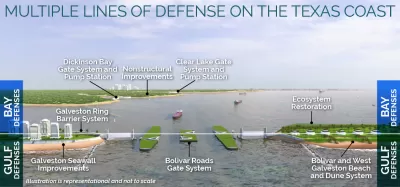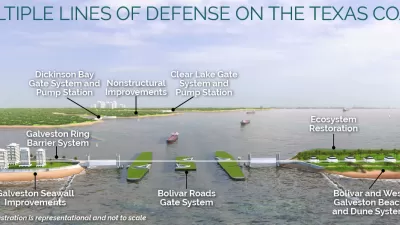Congress authorized the $31 billion ‘Ike Dike’ sea-level rise adaptation project, along with a laundry list of other water infrastructure projects.

Committees in the U.S. House of Representatives and the U.S. Senate have approved the biennial Water Resources Development Act (WRDA), which would authorize a long list of water infrastructure projects, including the $31 billon Ike Dike megaproject to protect the Texas coast around Galveston from rising waters.
According to an article by Jeff Davis for the Eno Center for Transportation, the WRDA authorizes projects for development by the U.S. Army Corps of Engineers. The projects still need to be funded by the Appropriations Committees. The list of projects to be authorized by the WRDA include navigation, flood risk management, hurricane and storm damage risk reduction, ecosystem restoration, and other projects, according to the article.
“That $31 billion Texas project – $19.2 billion federal share, and $11.7 billion non-federal share – is, by far, the largest project authorization anyone can remember seeing in a WRDA bill, ever, by a long shot. If the bill is enacted, that project would, single-handedly, erase the $17 billion of progress made by the [Infrastructure Investment and Jobs Act] towards paying down the old Corps unfunded backlog and push that backlog to new heights,” according to Davis.
The project—previously called the Coastal Texas Protection and Restoration Feasibility Study but referred to locally as the “Ike Dike”—is by far the biggest ticket on the list. “The name of the project as presented in the bill does not give a precise location, but the Chief of Engineers’ report on the Corps website makes it clear that the project is centered around a massive floodwall protecting Galveston Bay (and thus Houston) from storm surges coming in from the Gulf of Mexico,” according to Davis.
Additional coverage of the Ike Dike is available from an article by Francis Wilkinson for Bloomberg published on May 1.
Planetizen shared news of the Ike Dike when the project was made public in 2018 and again when revised plans were released in 2020.
FULL STORY: House, Senate Advance WRDA Bills Authorizing $31B Texas Megaproject

Study: Maui’s Plan to Convert Vacation Rentals to Long-Term Housing Could Cause Nearly $1 Billion Economic Loss
The plan would reduce visitor accommodation by 25,% resulting in 1,900 jobs lost.

North Texas Transit Leaders Tout Benefits of TOD for Growing Region
At a summit focused on transit-oriented development, policymakers discussed how North Texas’ expanded light rail system can serve as a tool for economic growth.

Using Old Oil and Gas Wells for Green Energy Storage
Penn State researchers have found that repurposing abandoned oil and gas wells for geothermal-assisted compressed-air energy storage can boost efficiency, reduce environmental risks, and support clean energy and job transitions.

Santa Barbara Could Build Housing on County Land
County supervisors moved forward a proposal to build workforce housing on two county-owned parcels.

San Mateo Formally Opposes Freeway Project
The city council will send a letter to Caltrans urging the agency to reconsider a plan to expand the 101 through the city of San Mateo.

A Bronx Community Fights to Have its Voice Heard
After organizing and giving input for decades, the community around the Kingsbridge Armory might actually see it redeveloped — and they want to continue to have a say in how it goes.
Urban Design for Planners 1: Software Tools
This six-course series explores essential urban design concepts using open source software and equips planners with the tools they need to participate fully in the urban design process.
Planning for Universal Design
Learn the tools for implementing Universal Design in planning regulations.
Ascent Environmental
Borough of Carlisle
Institute for Housing and Urban Development Studies (IHS)
City of Grandview
Harvard GSD Executive Education
Toledo-Lucas County Plan Commissions
Salt Lake City
NYU Wagner Graduate School of Public Service





























